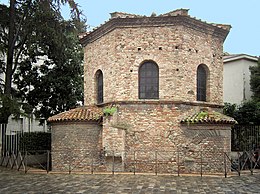
Back Баптистерий на арианите Bulgarian Baptisteri Arrià Catalan Baptisterium der Arianer German Βαπτιστήριο των Αρειανών Greek Ariana baptisterio Esperanto Baptisterio Arriano Spanish Baptistère des Ariens French בית הטבילה האריאני HE Arijanska krstionica Croatian Battistero degli Ariani Italian
| UNESCO World Heritage Site | |
|---|---|
 Arian Baptistry ceiling mosaic | |
| Location | Ravenna, Italy |
| Part of | Early Christian Monuments of Ravenna |
| Criteria | Cultural: (i), (ii), (iii), (iv) |
| Reference | 788-006 |
| Inscription | 1996 (20th Session) |
| Area | 0.008 ha (860 sq ft) |
| Buffer zone | 0.68 ha (73,000 sq ft) |
| Coordinates | 44°25′07″N 12°12′09″E / 44.41861°N 12.20250°E |

The Arian Baptistry in Ravenna, Italy is a Christian baptismal building that was erected by the Ostrogothic King Theodoric the Great between the end of the 5th century and the beginning of the 6th century A.D., at the same time as the Basilica of Sant' Apollinare Nuovo.
Theodoric the Great was an Arian Christian who spent his formative years as a hostage in Constantinople, where he received a comprehensive education that included imperial customs.[1] As an adult Theodoric's political cunning and martial feats gained him the respect of other Goths.[1] After years of movement within the Roman Empire, a treaty agreement with Emperor Zeno resulted in the Goths being given Ravenna to rule in the emperor's name.[1]
Arian Christianity required separate places of worship from Catholicism. Theodoric did not uproot the Chalcedonian Christians who lived in Ravenna. Instead, separate places of worship were commissioned, resulting in the construction of an Arian cathedral and baptistery.[2]
The octagonal baptistery was constructed with brick, and the interior would have been adorned by many mosaics, but today, only the dome's mosaic remains, depicting a scene of Jesus' baptism.[3]
The baptistery shares several similarities with the Orthodox Baptistery of Neon, in both structure and mosaic composition.
After Arianism was condemned the baptistery was converted into a Catholic structure. Today, the Arian Baptistery is registered as a UNESCO World Heritage Site.[4]
- ^ a b c Herrin, Judith (2020). "Theodoric the Ostrogoth". Ravenna: Capital of Empire, Crucible of Europe (1st ed.). Princeton University Press. pp. 89–100. ISBN 978-0-691-15343-8.
- ^ Deliyannis, Deborah; Dey, Hendrik; Squatriti, Paolo (2019). Fifty Early Medieval Things: Materials of Culture in Late Antiquity and the Early Middle Ages. Cornell University Press. doi:10.7591/j.ctt22p7hpc.15. ISBN 978-1-5017-3029-0.
- ^ Deliyannis, Deborah; Dey, Hendrik; Squatriti, Paolo (2019). Fifty Early Medieval Things: Materials of Culture in Late Antiquity and the Early Middle Ages. Cornell University Press. doi:10.7591/j.ctt22p7hpc.15. ISBN 978-1-5017-3029-0.
- ^ Centre, UNESCO World Heritage. "Early Christian Monuments of Ravenna". UNESCO World Heritage Centre. Retrieved 2024-05-08.
© MMXXIII Rich X Search. We shall prevail. All rights reserved. Rich X Search
